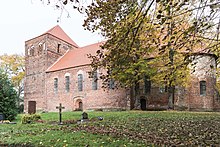St. Nikolaus (mountains)
The Protestant village church of St. Nikolaus is a late Romanesque brick church in the Berge district of Werben (Elbe) in the Stendal district in Saxony-Anhalt . It belongs to the church community Werben in the Stendal parish of the Evangelical Church in Central Germany and is a recognized cultural monument .
History and architecture
The Church of St. Nikolaus in Berge is an unusually large late Romanesque brick building, the choir of which was dendrochronologically dated to 1221d due to the preserved roof structure. It is one of the largest single-nave village church rooms in the central Elbe region and is located in the center of the round village of Berge near Werben. The size and the patronage mentioned as early as 1151 in the deed of donation of the Margrave of Brandenburg , as well as the town plan, suggest that Berge was planned as a market settlement. Construction seams on both sides of the hall indicate a construction freeze after construction of the eastern parts. A construction seam between the tower and the hall can be seen on the north side. The church was damaged in 1813 and restored in 1816/17.
The church consists of a mighty west tower with a rectangular plan, a nave of the same width with a recessed choir and a semicircular apse . As with other village churches in the succession of Jerichow monastery (for example the village churches Schönhausen , Redekin , Melkow and Großwulkow ), the decorative shapes are very carefully executed. They consist of corner pilasters that merge into triangular and cross-arched friezes at the eaves , as well as a rich base profile. The apse, the upper, plastered part of which has been renewed, is divided into three parts by flat pilaster strips that continue above the dew-like window sill as quarter columns with bases. The windows were later changed. The basement of the tower with an enormous wall thickness of 2.1 to 2.75 meters is vaulted with a transverse barrel. On the north side there is an early modern opening with a wooden staircase for easy access to the tower. At the exit above the transverse barrel, the double-broken staircase shows a still medieval oak plank door that is locked to the inside of the tower. Therefore, the church is seen as a "escape church".
On the west side of the tower and on both sides of the ship, three round arched portals with extraordinarily rich decorative shapes with stepped walls and inlaid beads in rectangular wall projections open up the building. At the choir, a simpler priest gate with beveled garments leads into the building. The upper floor of the tower is provided with coupled, ogival sound openings in round-arched panels and is closed off with a tent roof. It no longer belongs to the original Romanesque building. The interior of the church is flat-roofed and structured with a round-arched triumphal arch with fighters . The neo-Romanesque painting dates from the end of the 19th century.
Furnishing
The main piece of equipment is a high baroque pulpit altar from 1724, richly decorated with acanthus decorations and garlands. It shows an essay with ray glory and judgment angel and has lateral passages. The coat of arms of the von Kannenberg family is affixed to the sound cover. A remnant of a late Romanesque baptismal font made of sandstone should also be mentioned. An epitaph commemorates the pastor Christian Heinrich Runde, who lived from 1730 to 1798. The organ is a work by Friedrich Hermann Lütkemüller from 1875 with nine stops on a manual and pedal , which was restored by the Beckmann company in 2015.
Surroundings
In the cemetery there are two medieval stone crosses from the 15th century, which were supposedly set as atonement for the two sons of the village mayor who were shot in a divine judgment .
literature
- Georg Dehio : Handbook of the German art monuments. Saxony Anhalt I. District of Magdeburg. Deutscher Kunstverlag, Munich / Berlin 2002, ISBN 3-422-03069-7 , p. 96.
Web links
- Advertise Parish Area website
- Information about the history on the website of the Hanseatic city Werben
Individual evidence
- ↑ Short question and answer Olaf Meister (Bündnis 90 / Die Grünen), Prof. Dr. Claudia Dalbert (Bündnis 90 / Die Grünen), Ministry of Culture March 19, 2015 Printed matter 6/3905 (KA 6/8670) List of monuments Saxony-Anhalt
- ↑ a b c d Damian Kaufmann: The Romanesque brick village churches in the Altmark and in the Jerichower Land. Verlag Ludwig, Kiel 2010, ISBN 978-3-86935-018-9 .
- ↑ Thomas Hartwig: All Altmark churches from A to Z . Elbe-Havel-Verlag, Havelberg 2012, ISBN 978-3-9814039-5-4 , p. 571-572 .
- ↑ Thomas Hartwig: All Altmark churches from A to Z . Elbe-Havel-Verlag, Havelberg 2012, ISBN 978-3-9814039-5-4 , p. 44-45 .
- ↑ Information about the organ on orgbase.nl. Retrieved November 18, 2019 .
- ↑ Information on the history of the Berge district on the website of the Hanseatic City of Werben. Retrieved June 1, 2018 .
Coordinates: 52 ° 49 ′ 1 ″ N , 11 ° 59 ′ 58.3 ″ E


